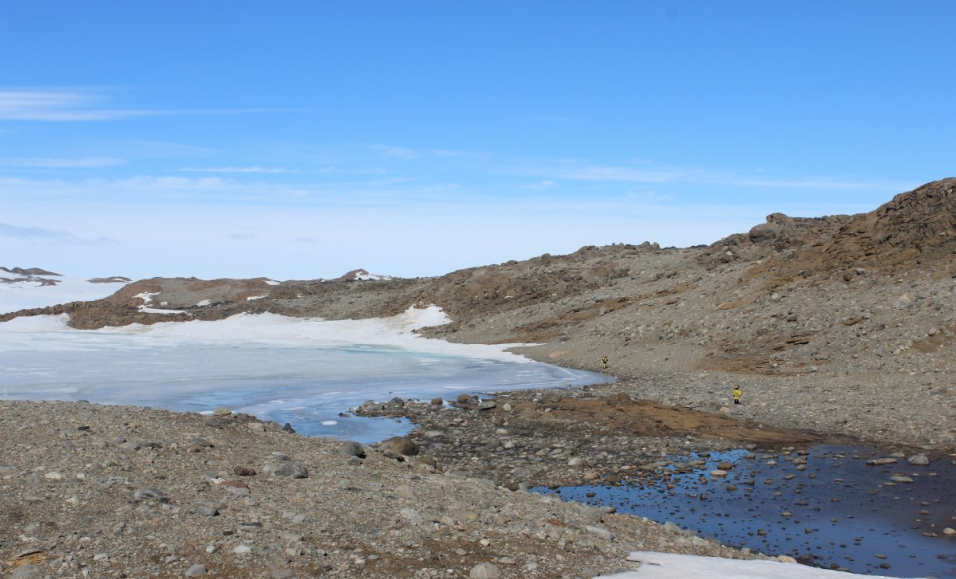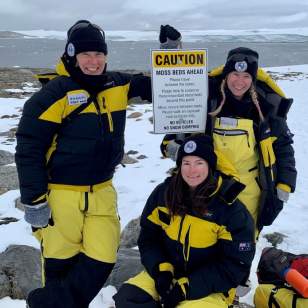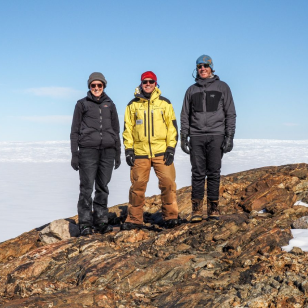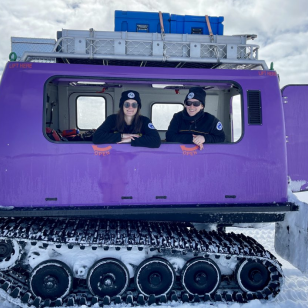SAEF Goes South: Aimee and Toby

Aimee Bliss and Toby Travers. Credit Barry Becker

One of the Antarctic lakes that Aimee and Toby sampled. Credit Aimee Bliss

Sampling frozen lakes. Credit Aimee Bliss
Heading South
The team is now back in Australia and we asked them to share what life is like working and living in this remote and wild place. First up, we have Aimee Bliss and Toby Travers.
To start, what did it feel like when you first got off the plane and set foot on the ice?
Toby: This was my first time to Antarctica. I have previously gone south with the AAD to Macquarie Island. Stepping off the plane was like stepping into the middle of a frozen ocean, a flat white sea of ice all around. It reminded me of sailing.
Aimee: This was my second trip to Antarctica. I was fortunate to visit the Antarctic Peninsula as part of the first Homeward Bound leadership expedition for women in science. This was my first time to an Australian base and flying to the continent.
Stepping off the plane onto the glacier 4.5 hrs after leaving Hobart was bizarre. There was ice in every direction merging into a grey sky. It feels vast and inhospitable, but also incredibly beautiful. It certainly makes you feel small!
“We were incredibly lucky with the weather and only lost half a day to the weather. One challenge was accessing lakes that had completely frozen over. We used a combination of tools to break the lake ice like ice saws, ice axes, and ice hammers. ”
— Toby Travers, SAEF
You both joined the SAEF team to collect soil and lake samples which will offer insights into the responses of life to the changing conditions in Antarctica. What did the sampling process involve and how successful were you?
Toby: We were tasked with conducting fieldwork for two projects. For the first we collected lake water and sediment samples from lakes across the Windmill Islands and peninsulas around Casey Station. These samples will help us understand the lake conditions and their drivers and how these influence the lakes’ phytoplankton communities.
For the second project, we collected soil samples from the top of a ridgeline just south of Casey Station in search of bacterial communities that represent the frontier of life on Antarctica and indeed on Earth. The sites we selected were deliberately chosen based on having no water or nutrient inputs and no visible signs of life (including human disturbance). In these mineral sand soils, seemingly devoid of life, we hope to find bacterial communities that harvest trace gases like hydrogen gas and carbon monoxide from the atmosphere to create their own water and sugars instead of relying on energy from the sun like plants do. We had to be careful not to contaminate samples by wearing face masks and gloves during sampling and will only know if we found them after DNA analysis of the soils back at the lab.
Many of the samples that you collected were from lakes in the region around Casey Station. These usually form when the surrounding ice melts in the warmer months. What kind of things did you notice about the lakes that were different to lakes you might encounter in Australia?
Aimee: We were very lucky to get to visit lots of lakes around Casey Station. They varied from small, shallow lakes with open water to expansive deep lakes covered in thick ice. The lakes occurred in basins and depressions and were gravel, pebble or rock bottomed. Seeing open fresh water in Antarctica, the driest continent on earth, was remarkable. The lack of surrounding vegetation compared to Australian lakes was clearly different. I imagine Antarctic lakes are what lakes in Australia would have looked like millions of years ago before life on land evolved.
What happens to the samples now?
Aimee: Our samples have been sent to Australia, where once they pass through biosecurity will go to labs at ANSTO and Monash University. Here they will be unfrozen and processed. The water samples will be analysed for stable isotopes, the lake bottom sediment for diatom species and the soil samples for trace gas scavenging microbes.
Expeditioners usually expect to lose several days to bad weather. How many days did you lose and were there any other challenges you encountered?
Toby: We were incredibly lucky with the weather and only lost half a day to the weather. One challenge was accessing lakes that had completely frozen over. We used a combination of tools to break the lake ice like ice saws, ice axes, and ice hammers. We also used a standard cordless drill with a long attachment used to drill through sea ice that was fast and effective. After drilling a number of pilot holes with the drill we then knocked out the middle plug to form a nice hole in the ice to access the lake water. While drilling these holes we discovered long icicles growing like stalactites from the roof of the lake. They were delicate lattices of ice and it looked like we had drilled into a chandelier when they all floated to the surface.
What is the best thing about life on Casey Station? What do you do when you’re not sciencing?
Toby: Meeting a whole community of people and learning what their jobs are on station and their personal stories, sharing interests with new people and getting beaten at darts and table tennis. There is an amazing diversity of jobs that are required to run Antarctic stations from plumbers to cooks, doctors, pilots, plant operators, mechanics, weather observers and field training officers so it’s great to learn all the aspects that go together to make station life. On station I really enjoyed solo walks up a nearby hill to watch the seals and penguins in the distance, the skuas eyeing you off from overhead and the Wilson’s Storm-petrels flitting about the rocks like welcome swallows. It was a really special experience.
Aimee: I would agree with Toby. The best thing about spending time at an Antarctic base is the community. You meet all sorts of people and make friends quickly. I enjoyed going on the ski-loop around station, watching midnight sunsets reflecting on icebergs across the bay followed by midnight cups of tea and toasties with other expeditioners on Antarctic time zones.
Finally, why do we need to secure Antarctica’s environmental future?
Aimee: Firstly, so that the awesome landscapes and incredible life we witnessed can continue to exist, survive and thrive at the bottom of the world.
Secondly, because what happens to Antarctica impacts the rest of the world. If we want to maintain a liveable planet full of diversity we must secure Antarctica’s environmental future.
Toby: I feel strongly about securing the environmental future of all natural places. Antarctica is a unique and special place but it is also a big white canary in the coal mine. When parts of its climate system start to show signs of stress it will have a massive influence on climate change in Australia and the rest of the world. So by securing Antarctica’s environmental future, hopefully we can ensure a stable future for ourselves and the next generation.


